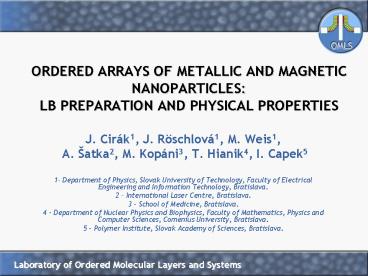ORDERED ARRAYS OF METALLIC AND MAGNETIC NANOPARTICLES: LB PREPARATION AND PHYSICAL PROPERTIES - PowerPoint PPT Presentation
1 / 25
Title:
ORDERED ARRAYS OF METALLIC AND MAGNETIC NANOPARTICLES: LB PREPARATION AND PHYSICAL PROPERTIES
Description:
1 Department of Physics, Slovak University of Technology, Faculty of Electrical ... films are compact multilayers of surfactant molecules produced by the Langmuir ... – PowerPoint PPT presentation
Number of Views:271
Avg rating:3.0/5.0
Title: ORDERED ARRAYS OF METALLIC AND MAGNETIC NANOPARTICLES: LB PREPARATION AND PHYSICAL PROPERTIES
1
ORDERED ARRAYS OF METALLIC AND MAGNETIC
NANOPARTICLESLB PREPARATION AND PHYSICAL
PROPERTIES
- J. Cirák1, J. Röschlová1, M. Weis1,
- A. atka2, M. Kopáni3, T. Hianik4, I. Capek5
- 1 Department of Physics, Slovak University of
Technology, Faculty of Electrical Engineering and
Information Technology, Bratislava. - 2 International Laser Centre, Bratislava.
- 3 - School of Medicine, Bratislava.
- 4 - Department of Nuclear Physics and Biophysics,
Faculty of Mathematics, Physics and Computer
Sciences, Comenius University, Bratislava. - 5 - Polymer Institute, Slovak Academy of
Sciences, Bratislava.
Laboratory of Ordered Molecular Layers and Systems
2
Introduction
- Subject of nanotechnology
- Controlled manufacturing and characterization
of materials and systems with predetermined and
artificially modified atomic and molecular
structure. Nanoscience is actually Materials
Science at atomic level. - To accomplish that one needs to manipulate with
atoms and molecules at nanoscale. - The word nano relates to the dimension scale
comparable with 1nm 10-9 m. - Typical size of nanoobject ranges from 1 to 100
nm.
3
Approach
Nanostructure and device can be accomplished by
two approaches
- large object are modified to give smaller features
- small building blocks are produced and assembled
into larger structures
R. Feynman There is plenty room at the bottom
4
Organic molecules - advantages
- Size 1 100 nm, the scale that permits
functional nanostructures - Self assembly specific intermolecular
interactions for the formation of spatial and
temporal structures - Molecular recognition extreme selectivity for
the formation of intermolecular bonding - Dynamical stereochemistry multiple distinct
geometric structures or isomers with different
properties - Synthetic taylorability choice of composition
and geometry which enables to vary molecules
properties
5
Properties of organic molecular systems
- physical properties can be purposefully modified
by minor changes in the molecular structure - various advantageous properties can be associated
at the molecular level with possibility to form
supramolecular ordered (organized) systems - functionality of these systems is preserved on
various length scales (molecules, nanoparticles,
thin films, clusters, bulk) - materials are biologically and environmentally
compatible, recycling of products - exploitation of the materials is not directly
dependent on strategic raw materials
6
Langmuir-Blodgett technique
enables to form highly ordered monomolecular
amphiphilic films at the air-water interface and
subsequently to transfer on a solid support
- Amphiphilic molecules consist of a
hydrophilic(water soluble) and a
hydrophopic(water insoluble) part. - This amphiphilic nature of molecules is
responsible for their association behaviour in
solution and their accumulation at interfaces.
7
Langmuir-Blodgett technique
- LB-films are compact multilayers of surfactant
molecules produced by the Langmuir-Blodgett
deposition technique onto solid surface.
8
Materials
- Fatty acids
- Phospholipids
- Proteins
- Fullerene
- And many others
9
Experimental study of physical properties of LB
films
- Nanoelectric phenomena in Langmuir monolayer
- LB deposition of alternating monomolecular layers
- LB surface modification for electrochemical
sensors - Polarised luminiscence from LB structures
- Organised LB systems of organometallic
nanoparticles - Interaction of molecules in biomembranes
10
Metallic Nanoparticles
- Metallic nanoparticles include single metals,
mainly transition metals, alloyed metals and
metal oxide - The applications of metallic nanoparticles are
mainly - high density magnetic data storage
- biomedical applications
- highly active catalyst
- nanotubes
- magnetic liquids
Dai et al (2002)
11
LB-film preparation
12
LB-film preparation
13
Experimental Results
- Various techniques of surface analysis were used
for measurement of physical and structural
properties of planar array of magnetic
nanoparticles - MAXWELLS DISPLACEMENT CURRENTS
- TRANSMISSION ELECTRON MICROSCOPY
- SCANNING ELECTRON MICROSCOPY
- ELLIPSOMETRY
14
MDC Measurement
- Observation of the dynamic response
- Change of a) order
- b) dipole moment
- c) number of molecules
15
MDC Measurement
- Observation of the dynamic response
- Change of a) order
- b) dipole moment
- c) number of molecules
16
Dipole Moment Measurement
17
Dipole Moment Measurement
18
Transmission Electron Microscopy
19
Scanning Electron Microscopy
20
Ellipsometry
21
Voltammetry signal (electrochemical Coulomb
staircase) of iron oxide nanoparticles on the
a-SiH electrode. Individual changes in charge
states are indicated.
22
Summary
- SEM as well as TEM confirmed highly monodisperse
character of NPs - Large-scale homogeneity and high quality
multi-layer structure was observed for various
deposition conditions by micrographs and
ellipsometry measurement
23
Cooperation
- Nanoelectric phenomena in Langmuir monolayer
- M. Iwamoto, Inst. of Physical Electronics, TIT
Tokyo, Japan - S. Nepurek, Inst. of Macromolecular Chemistry,
ASCR, Prague - LB layers of functionalized heterocyclic polymer
layers - G. Cík, Dept. of Environ. Sci., FChPT, STU
Bratislava - LB surface modification for electrochemical
sensors - K. Gmucová, V. Nádady, Inst. of Physics SAS,
Bratislava
24
Cooperation
- Polarised luminiscence from LB structures, OLEDs
and FETs - Bolognesi, Inst. of Macromolecular Chemistry,
CNR, - Milano, Italy
- J. Kovác, ILC, Bratislava
- R. Resel, Techn. Univ. of Graz, Austria
- Organised LB systems of metal and magnetic
nanoparticles - D. Petridis, Inst. of Materials Science,
Demokritos, Athens, Greece - A. atka, ILC, Bratislava
- E. Majková, Inst. of Physics, SAS Bratislava
- I. Capek, Inst. of Polymers, SAS Bratislava
- Biological membranes
- T. Hianik, P. Vitovic, Fac. of MPI, Comenius
Univ., Bratislava - P. Balgavý, D.Uhríková, Fac. of Pharmacy,
Comenius Univ., Bratislava
25
Thank you for attention.































